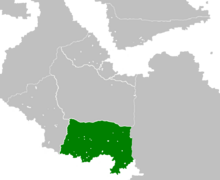Confederation of Ancapistan: Difference between revisions
(Created page with "{{WIP}} {{Infobox former country |native_name = Konfederasyona Ancapistane |conventional_long_name = Confederation of Ancapistan |common_name = |contin...") |
mNo edit summary |
||
| Line 138: | Line 138: | ||
[[Category:Liberto-Ancapistan]] | [[Category:Liberto-Ancapistan]] | ||
[[Category:Predecessor states of Liberto-Ancapistan]] | |||
Revision as of 12:52, 6 November 2022
This article is incomplete because it is pending further input from participants, or it is a work-in-progress by one author. Please comment on this article's talk page to share your input, comments and questions. Note: To contribute to this article, you may need to seek help from the author(s) of this page. |
Confederation of Ancapistan Konfederasyona Ancapistane | |||||||||||
|---|---|---|---|---|---|---|---|---|---|---|---|
| 1844–1955 | |||||||||||
|
Flag of Ancapistan (1844 - 1955) | |||||||||||
 The borders of the Confederation of Ancapistan 1844 - 1955 | |||||||||||
| Capital | An Alqam | ||||||||||
| Common languages | Basaquese, Santian | ||||||||||
| Government | Confederal constitutional emirate | ||||||||||
| Emir | |||||||||||
• 1844-1866 | Leyla Abdana I | ||||||||||
• 1947-1955 | Zahir Sa IX | ||||||||||
| Chancellor | |||||||||||
• 1844 - 1852 | Piran Bokolu | ||||||||||
• 1953 - 1955 | Nadia Dogamatina | ||||||||||
| Legislature | Grand Council of Ancapistan | ||||||||||
| History | |||||||||||
• Abdanas Decree | 2nd May 1844 | ||||||||||
• Unification of Liberto-Ancapistan | 21st March 1955 | ||||||||||
| Currency | Ancapistanian Fiat | ||||||||||
| |||||||||||
The Confederation of Ancapistan (Basaquese: Konfederasyona Ancapistane) was a confederation in southern Basaquastan, existing between 1844 and 1955. Comprising of modern-day Ancapistan Province, it was formed from the historical regions of Ancapistan, Nizmstan, and the Tabariere Peninsula.
The confederation was formed in the aftermath of the Summer Revolution, from the various anti-Santian forces of that conflict. While the revolution in Libertarya had a clear, centralised leadership, resistance was far more diffuse in Ancapistan, with two largely opposed centres of power in the Emirate of Nizmstan, a rebellious vassal of the Santian Empire, and an army of peasant rebels formerly headed by Sayab Etyio. In order to create a functioning government, both groups agreed to a compromise in which a confederation would form under the nominal leadership of the Nizmstani Emir, but comprise of autonomous settlements outside the boundaries of Nizmstan itself. The central government of Ancapistan had very limited powers, largely limiting itself to diplomatic and military roles. Most administrative work depended on the constituent political entities of the confederation, ranging in size from Nizmstan - which covered two thirds of Ancapistan's land area and over half of its population - to village-sized units with populations in the hundreds. Western Ancapistan was the first part of Basaquastan to industrialise, with foreign industrialists including Hector Rand exploiting the political situation of the country to create semi-colonial company towns. During the later decades of its existence, Ancapistan saw smaller political units increasingly amalgamate into larger groups, being federated as a single administrative province following the unification of Liberto-Ancapistan.
